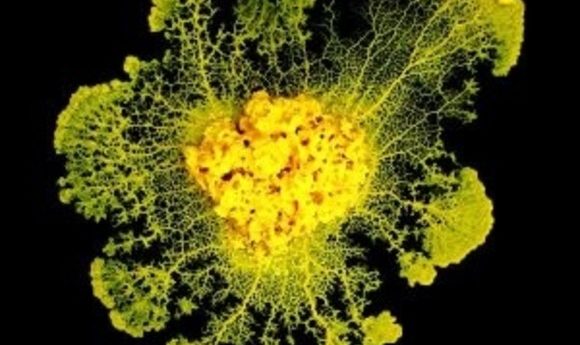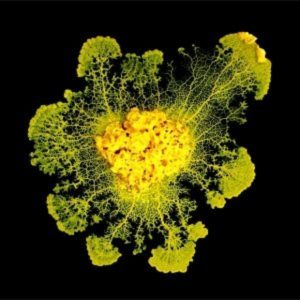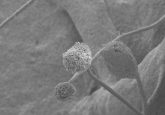No brain? No problem!

Being brainy doesn’t make you smart. A brainless slime mold proves this by learning new abilities—then teaching them to others.

P. polycephalum
Oozing around at a maximum speed of 4 centimeters per hour, a slime mold with an appetite can accomplish just about anything: solve mazes, escape traps, and mimic complex networks (think rail systems and interstate highways). Recently, researchers from Paul Sabatier University in Toulouse, France added another remarkable ability to the long list of cognitive-like functions this brainless protist possesses.
Physarum polycephalum—the giant, single-celled slime mold—can learn new behaviors and then teach its newfound knowledge by fusing with “naïve” slimes. The researchers reported this primitive form of learning, known as “habituation,” in the journal Proceedings of the Royal Society B.
“Studying a unicellular organism is really interesting because it is easier to understand the underlying process allowing a behavior to emerge,” said David Vogel, lead author of the study and PhD student at Paul Sabatier University. “I always enjoyed showing that a simple organism is able to have complex behavior.”
Inhabiting rotting logs and decaying leaves, P. polycephalum can be as small as the microbes it feasts on or extend as large as several meters in multiple directions. It can separate and recombine, all while remaining as one, multinucleated mass called a plasmodium. As a plasmodium, the slime mold is all about finding efficient routes to food.
By exploiting this drive to eat, the researchers designed an experiment to test the slime’s wit. They created a small bridge covered in harmless table salt, which usually repulses slime molds. Eventually the slime learned that the bridge was safe to cross so that it could eat its meal.
Next, the team brought in new, naïve slime molds for their first encounter with the salty bridge. When testing the new group with the habituated group, fusion naturally commenced, and knowledge began to spread. It only took a single habituated slime to teach one or more naïve slimes that the salt bridge was safe to cross. Even more surprising, the naïve slime’s tendrils would reach for the food before the habituated counterparts did. “It was really an unexpected result. For us, it was a proof that there was a transfer between the two merged slime molds,” Vogel said.
The longer the habituated and naïve slimes were fused, the more habituated the naïve slimes became after separating. Vogel suggested that this collective knowledge is important for the survival of individual, or separated, slimes. But what exactly is getting transferred and retained as information?
The team hypothesizes that when slime molds repeatedly habituate to a repulsive stimulus, new molecules form in the cell that allow them to ignore the stimulus; unhabituated slime molds could then “learn” by obtaining these molecules.
Simon Garnier from the New Jersey Institute of Technology, who was not involved with the study, believes that clues for testing Vogel’s hypothesis about how non-neuronal creatures share information may be found in the recent release of P. polycephalum’s genome.
“[This slime mold] will greatly help us understand how the vast majority of living things [such as plants, microbes, and fungi] solve the same complex problems as us but without a dedicated computing organ,” Garnier said. “Just keep an eye out on slime mold research. I am convinced that more exciting results are around the corner.”
